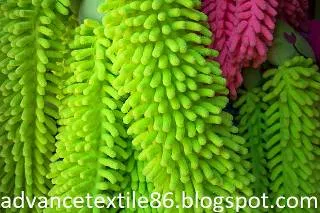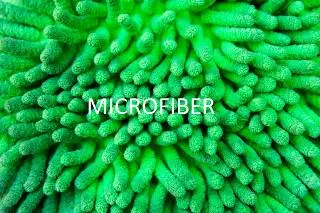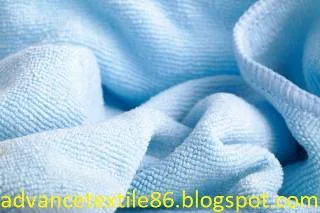Microfiber
Microfiber
is defined as a filament of core fiber or linear density of about 1 dtex or
less and above 0.3 dtex. Although acrylic, viscose, and polypropylene are
available for microfiber production, polyester and polyamide are the main
sources. Fabrics made from these fibers can be 100% microfiber or blended with
wool, cotton, or viscose. Microfibers are half the diameter of fine silk
fibers, one-third the diameter of cotton, one-fourth the diameter of fine wool,
and one hundred times finer than a human hair. To be classified as microfiber,
the fiber should be less than 1 dtex in width. Fabrics made with microfibers
are usually lightweight, prevent wrinkles, have luxurious drops on the body,
retain shape and prevent peeling. They are relatively strong and durable in the
case of other fabrics of similar weight and they are more breathable and more
comfortable to wear. Fabrics made with microfibers conduct less heat and
therefore show higher thermal insulation properties. Microfiber fibers show a
warmer feeling than conventional fabrics depending on the pressure that can be
caused by the difference in fiber and fabric surface in contact with human
skin.
The different manufacturing processes of microfibers
Three
conventional spinning methods, namely melt spinning, dry spinning, and wet
spinning can be used to make microfibers. However, to produce microfiber by
these methods, the polymerization process, polymer spinning, and drawing
conditions have to be selected and performed very carefully. The technology
involved in the extraction of microfibers is more sophisticated and expensive
than conventional deniers, because microfibers are a delicate product that
requires extreme care when handling textile mill processing. Microfiber
spinning is now made possible by many large fiber manufacturers in their
existing equipment, but the economical production of high-quality microfibers
will require significant changes in the design and operation of future
machines. Other processes are-
i.
Dissolved type
ii.
Split type
iii.
Direct spun type
iv.
Super-drawing technique
v.
Sheath-core spinning method
vi.
Flash-spinning method
vii.
Solution flash-spinning
viii.
Emulsion-spinning method
ix.
Jet-spinning method
x.
Centrifugal-spinning method
xi.
Turbulent forming method
xii.
Conjugate-spinning method.
Microfiber yarns
Microfibers
are extra fine fibers with an incredible fineness that change the properties of
regular-sized fibers and give them a great hand and drape. In the case of
spinning, multiple microscopic-sized filaments or fibers have more speed and
allow the fibers to move more lightly to prevent further yarn and damage to
their yarn structure. As a result, the knits do not sag. These seem to absorb
moisture and breathe better. Microfiber knits feel more like natural fibers and
feel less sticky in warm weather than regular synthetic yarns. Microfiber yarn
has a unique structure that works in a capillary manner and makes the dirt so
small that it removes it that cannot be detected to the human eye. Dirt and
soiling are removed from the surface into the cloth.
Fabrication of microfiber
Microfibers
are those that have less than one amount of rejection which makes them as
delicate as the silk fibers of cultivation. It is not impossible to cut into
yarns and fabric after making microfibers, this is a challenge due to the
fragility of the fibers. Thus, the most common method for making microfiber
fabrics is to extrude fine polyester filaments into a thin stream of
polyethylene. Each filament fiber - part styrene in the matrix format and part
filaments are of standard denier. These filament fibers, gathered into the
filament yarn, are knitted or woven to form a fabric. The next step is to pass
the fabric through a solvent bath to remove the polystyrene, thus freeing the
fine fibers of nylon or polyester. Organic solvents must be used to remove
polystyrene, a process that creates environmental and flammability concerns.
Attempts have been made to replace poly-styrene with water-soluble polymers but
it is expensive and the filaments become stiff when the aqueous fiber is
finished or moisture is absorbed from the air.
Uses of microfiber
There
are different uses of microfiber as follows-
1.
Microfiber fabric is frequently used for athletic wear, such as cycling
jerseys.
2.
It is suitable for undergarments.
3.
It can be used to make tough, very soft-to-the-touch materials for general
clothing use.
4.
Microfiber fabric can also be used for making bathrobes, jackets, swim trunks,
and other clothing.
5.
It is used to make many accessories such as wallets, handbags, backpacks, book
covers, shoes, cell phone cases, and coin purses.
6.
This fabric can be used for cleaning products.
7.
Microfiber is used in non-sports-related clothing, and furniture.
8.
Microfiber towels are used by car detailers and enthusiasts in a similar manner
to chamois leather.
9.
Microfiber materials such as PrimaLoft are used for thermal insulation as a
replacement for down feather insulation in sleeping bags and outdoor equipment.
10.
It is used for water insulation in automotive car covers.
11.
Microfibers are used in tablecloths, furniture, and car interiors are designed
to repel wetting and consequently are difficult to stain.
12.
Microfiber is used for other applications such as menstrual pads, cloth diaper
inserts, body scrubbers, face molds, whiteboard cleaners, and various things
that are needed to absorb water and/or attract small particles.











0 Comments